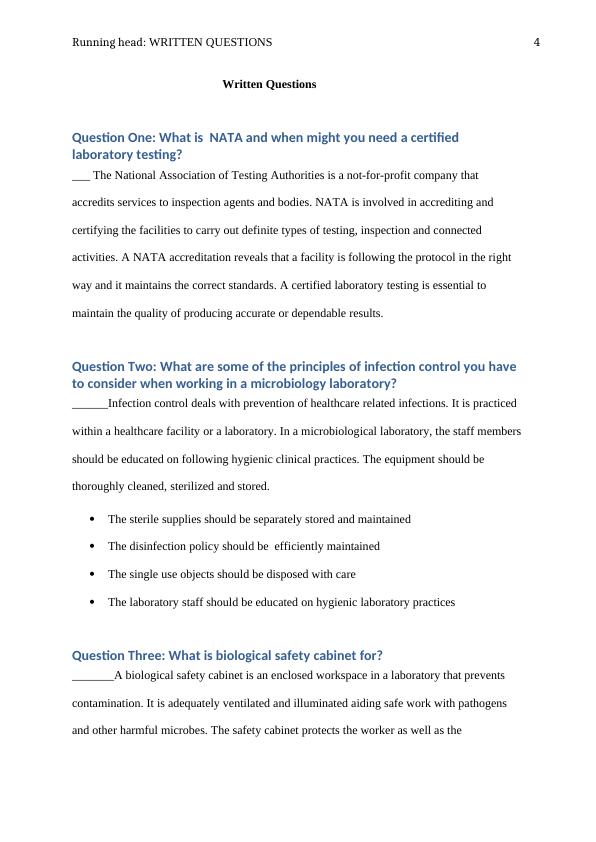Written Questions
Answering a series of questions related to microbiology
11 Pages2267 Words106 Views
Added on 2023-04-07
About This Document
This document provides answers to written questions on various topics including NATA, infection control, biological safety cabinet, bacterial reproduction, differences between viruses, bacteria, and molds, and more. It also includes a cleaning schedule for a deli.
Written Questions
Answering a series of questions related to microbiology
Added on 2023-04-07
ShareRelated Documents
Running head: WRITTEN QUESTIONS 1
Written Questions
Student’s name
Course
Institution
Date
Written Questions
Student’s name
Course
Institution
Date

Running head: WRITTEN QUESTIONS 2
Contents
Question One: What is NATA and when might you need a certified laboratory testing?..2
Question Two: What are some of the principles of infection control you have to consider
when working in a microbiology laboratory?...................................................................................... 2
Question Three: What is biological safety cabinet for?....................................................................2
Question Four: Describe how bacteria reproduce and draw the bacterial growth curve
describing the difference phases and why they occur (including a diagram and
description of each phase)........................................................................................................................... 3
Question Five: If you have a sandwich that has 3 S.aureus cells present and it was left in
ideal growth conditions for 4 hours – How many generations would be present? How
many cells would be now in the sandwich?.......................................................................................... 3
Question Six: Briefly explain the difference between the reproduction of viruses,
bacteria and mould......................................................................................................................................... 3
Question Seven: Describe the difference between pili and flagella and the different roles
they play for an organism............................................................................................................................. 4
Question Eight: How does the concentration of solutes in a solution affect the movement
of water across a semi permeable membrane of cells in that solution?....................................4
Question Nine: Classification in Microbiology is based on a number of processes and
principles. One species is likely to differ from another in a number of ways. Briefly
explain some differences that might occur from the following criteria: Morphology,
Biochemistry and Nutritional requirements........................................................................................ 5
Question Ten: Identify the main differences between animal, plant and bacterial cells....5
Question Eleven: Draw and explain the following components of a cell. (cytoplasm,
vacuole, mitochondria, nucleus)................................................................................................................ 6
Question Twelve: Explain the process of disinfection and sterilisation. Use at least two
examples of each in their practical use in production......................................................................6
Question Thirteen: Explain the different ways quality assurance of media is carried out
both when it is prepared and when it is used...................................................................................... 6
Question Fourteen: Identify at least 4 factors a microbiologist needs to consider when
selecting a sampling plan for testing products and explain why.................................................7
Question Fifteen: You own a small deli that has food displayed in a refrigerated cabinet.
You slice meats on a slicer and prepare other ingredients by slicing on a chopping
board. You use tongs to select the food for the customer and place it in containers for
take away services. In this exercise you are to complete the following cleaning schedule
for the deli including:..................................................................................................................................... 7
Question Sixteen: What are the possible consequences of not following a strict cleaning
regime?................................................................................................................................................................. 8
Question Seventeen: Briefly describe the legal responsibilities in maintaining a food
production area clean and sanitised? Hint:
http://www.comlaw.gov.au/Details/F2012C00774........................................................................8
_____..................................................................................................................................................................... 8
Question Eighteen: How should media be labelled and stored after preparation?..............8
Contents
Question One: What is NATA and when might you need a certified laboratory testing?..2
Question Two: What are some of the principles of infection control you have to consider
when working in a microbiology laboratory?...................................................................................... 2
Question Three: What is biological safety cabinet for?....................................................................2
Question Four: Describe how bacteria reproduce and draw the bacterial growth curve
describing the difference phases and why they occur (including a diagram and
description of each phase)........................................................................................................................... 3
Question Five: If you have a sandwich that has 3 S.aureus cells present and it was left in
ideal growth conditions for 4 hours – How many generations would be present? How
many cells would be now in the sandwich?.......................................................................................... 3
Question Six: Briefly explain the difference between the reproduction of viruses,
bacteria and mould......................................................................................................................................... 3
Question Seven: Describe the difference between pili and flagella and the different roles
they play for an organism............................................................................................................................. 4
Question Eight: How does the concentration of solutes in a solution affect the movement
of water across a semi permeable membrane of cells in that solution?....................................4
Question Nine: Classification in Microbiology is based on a number of processes and
principles. One species is likely to differ from another in a number of ways. Briefly
explain some differences that might occur from the following criteria: Morphology,
Biochemistry and Nutritional requirements........................................................................................ 5
Question Ten: Identify the main differences between animal, plant and bacterial cells....5
Question Eleven: Draw and explain the following components of a cell. (cytoplasm,
vacuole, mitochondria, nucleus)................................................................................................................ 6
Question Twelve: Explain the process of disinfection and sterilisation. Use at least two
examples of each in their practical use in production......................................................................6
Question Thirteen: Explain the different ways quality assurance of media is carried out
both when it is prepared and when it is used...................................................................................... 6
Question Fourteen: Identify at least 4 factors a microbiologist needs to consider when
selecting a sampling plan for testing products and explain why.................................................7
Question Fifteen: You own a small deli that has food displayed in a refrigerated cabinet.
You slice meats on a slicer and prepare other ingredients by slicing on a chopping
board. You use tongs to select the food for the customer and place it in containers for
take away services. In this exercise you are to complete the following cleaning schedule
for the deli including:..................................................................................................................................... 7
Question Sixteen: What are the possible consequences of not following a strict cleaning
regime?................................................................................................................................................................. 8
Question Seventeen: Briefly describe the legal responsibilities in maintaining a food
production area clean and sanitised? Hint:
http://www.comlaw.gov.au/Details/F2012C00774........................................................................8
_____..................................................................................................................................................................... 8
Question Eighteen: How should media be labelled and stored after preparation?..............8


Running head: WRITTEN QUESTIONS 4
Written Questions
Question One: What is NATA and when might you need a certified
laboratory testing?
___ The National Association of Testing Authorities is a not-for-profit company that
accredits services to inspection agents and bodies. NATA is involved in accrediting and
certifying the facilities to carry out definite types of testing, inspection and connected
activities. A NATA accreditation reveals that a facility is following the protocol in the right
way and it maintains the correct standards. A certified laboratory testing is essential to
maintain the quality of producing accurate or dependable results.
Question Two: What are some of the principles of infection control you have
to consider when working in a microbiology laboratory?
______Infection control deals with prevention of healthcare related infections. It is practiced
within a healthcare facility or a laboratory. In a microbiological laboratory, the staff members
should be educated on following hygienic clinical practices. The equipment should be
thoroughly cleaned, sterilized and stored.
The sterile supplies should be separately stored and maintained
The disinfection policy should be efficiently maintained
The single use objects should be disposed with care
The laboratory staff should be educated on hygienic laboratory practices
Question Three: What is biological safety cabinet for?
_______A biological safety cabinet is an enclosed workspace in a laboratory that prevents
contamination. It is adequately ventilated and illuminated aiding safe work with pathogens
and other harmful microbes. The safety cabinet protects the worker as well as the
Written Questions
Question One: What is NATA and when might you need a certified
laboratory testing?
___ The National Association of Testing Authorities is a not-for-profit company that
accredits services to inspection agents and bodies. NATA is involved in accrediting and
certifying the facilities to carry out definite types of testing, inspection and connected
activities. A NATA accreditation reveals that a facility is following the protocol in the right
way and it maintains the correct standards. A certified laboratory testing is essential to
maintain the quality of producing accurate or dependable results.
Question Two: What are some of the principles of infection control you have
to consider when working in a microbiology laboratory?
______Infection control deals with prevention of healthcare related infections. It is practiced
within a healthcare facility or a laboratory. In a microbiological laboratory, the staff members
should be educated on following hygienic clinical practices. The equipment should be
thoroughly cleaned, sterilized and stored.
The sterile supplies should be separately stored and maintained
The disinfection policy should be efficiently maintained
The single use objects should be disposed with care
The laboratory staff should be educated on hygienic laboratory practices
Question Three: What is biological safety cabinet for?
_______A biological safety cabinet is an enclosed workspace in a laboratory that prevents
contamination. It is adequately ventilated and illuminated aiding safe work with pathogens
and other harmful microbes. The safety cabinet protects the worker as well as the

End of preview
Want to access all the pages? Upload your documents or become a member.
Related Documents
What is NATA and when might you need a certified laboratory testing?lg...
|12
|2693
|692
BHS002: Microbiology & Biochemistrylg...
|18
|3640
|253
Microorganisms, Infection and Immunity 2: Literature Comprehension Testlg...
|10
|1230
|418
